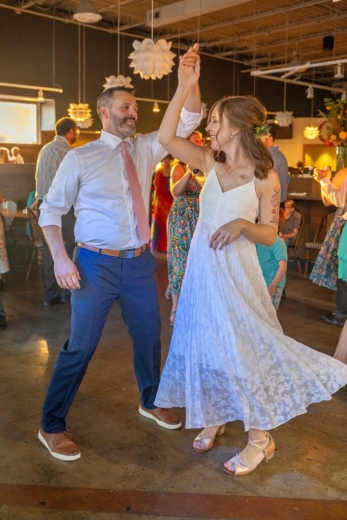After years of chronic pain, my own body was a frightening stranger - I wanted to be stronger before my wedding

Claire Richmond and Michael dance at their wedding. (Photo courtesy of Rachel Mummey)
Iowa Writers 'Collaborative. Linking Iowa readers and writers.On that July morning Bridget Schneider left the door of her fitness studio propped open, as if she knew how hard it would be for me to walk inside. I found her with a notebook in hand, ready to start my initial assessment. I was weeks away from marrying Michael, my partner of seven years, and wanted to feel stronger for our big day.
The air smelled fresh, neat shelves of weights sat under the windows, and the opposite wall was painted with a whimsical accent. I interpreted these details as aspects of a women-owned gym. Easing into the cozy, charcoal-colored loveseat by the door, I let myself sit back.
“Were you thinking you wanted virtual or in-person training? We can also do a combination of both.” Bridget perched at the end of a weight bench, balancing a laptop on her knees.
“In-person would be great,” I replied. I benefit from that human connection.
“I want to understand more about what you’d like to get out of personal training,” she looked at me expectantly.
“I think you know I, too, have a chronic illness,” I started.
I don’t make goals anymore.
Everything I ask of my body is an experiment. I could once travel the world on planes, miss nights of sleep, drink glasses of wine and skip meals without serious consequences. I have acute hepatic porphyria (AHP), a rare metabolic disorder that produces chronic symptoms and acute attacks. My disease doesn’t follow a schedule, high-intensity workouts provoke flares, and lingering paralysis leads to muscle rigidity and weakness. These days, I walk a fine line doing anything that puts stress on my body, including certain medications, food, and exercise.
I went 19 years being told by medical professionals that there was no reason for my pain, that my invisible symptoms were the result of toxic stress and mental illness. By the time I received my diagnosis at 32, I was so brainwashed that even with this new information I didn’t take my body seriously. I minimized discomfort and pain. By doubting my illness and passing judgment on my new limitations, I gaslit myself.
I lived with AHP-related chronic pain for years before I was able to advocate enough for myself that I got help. The first pain specialist I saw refused to learn about my disease. At our first appointment, she told me I was half the age of the rest of her patients and would only work with me if I had a goal. Learning to accept my body’s limitations and live in pain every day wasn’t good enough. I never saw that practitioner again.
I knew a pain-free existence wasn’t realistic with AHP, and I was tired of pushing my body in pursuit of society’s expectations. I was sick of punishing myself for my own acceptance, or to accomplish some arbitrary goal.
Goal-setting is a sensitive topic for me, a competitive, recovering capitalist. I used to be all about SMART (Specific, Measurable, Achievable, Relevant, and Time-Bound) goals, but anymore this approach feels ableist and defeating. Now, I adopt goals that are FUN (Flexible, Uplifting, and Numberless). I first read of this concept from disability advocate and author Emily Ladau. I’m measuring my worth based on how well I live my values, not on what I accomplish or achieve.
In Bridget’s studio, I struggled to separate my medical trauma from my present fitness assessment. I turned my gaze towards a Himalayan salt lamp, glowing orange on a windowsill, and took a deep breath.
“We don’t have to have specific goals,” she assured me. Bridget opened up about her chronic illness and admitted she sometimes has to cancel at the last minute too.
“I’m scared of my own body,” I heard myself say to the lamp, to Bridget, to myself.
I’d never uttered these words before, but I instantly knew them to be true. Catching a tear with a flick of my ring finger, I turned my attention back to Bridget. She nodded, “I’ll start you off slow. You may even be too bored with what we do!”
That was fine with me. I scheduled a month’s worth of twice weekly sessions leading up to the wedding and felt confident going into our first 30-minute training session. Bridget led me through a series of dynamic stretching and a circuit of strengthening exercises, all tailored to me.
Driving home, I was optimistic. My muscles felt activated, but not fatigued. Allowing my body some space, I spent the rest of the afternoon sitting on my front porch with my journal. The next day I texted Bridget, “Let’s ramp it up a little. I’m feeling good!”
On my wedding day, Michael and I danced to “My Girl.” He spun me around, then held me close, our steps in sync thanks to dozens of lessons.
“You look beautiful,” he whispered into my ear.
“I feel confident and strong,” I smiled, as he spun me again.
I may never again know the freedom I had before illness progression. But if I’m too scared to try new things, my body will remain a stranger.
This column was originally published by Mary Swander’s Emerging Voices. It is republished here via the Iowa Writers’ Collaborative.
Editor’s note: Please consider subscribing to the collaborative and its member writers to support their work.
©Copyright 2024, Iowa Capital Dispatch. Published under Creative Commons license CC BY-NC-ND 4.0. Read more at iowacapitaldispatch.com.
Category:
The Eagle Grove Eagle
The Eagle Grove Eagle
P.O. Box 6
304 West Broadway
Eagle Grove, IA 50533
Phone: 1-515-448-4745
FAX: 1-515-448-3182
Email: news@eaglegroveeagle.com
Mid-America Publishing
This newspaper is part of the Mid-America Publishing Family. Please visit www.midampublishing.com for more information.